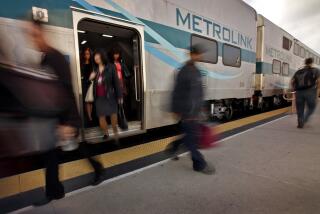Right Side of the Tracks : Metrolink Stations Will Become Commercial Hubs, Officials Predict
As Claremont officials staged trackside ceremonies with speeches, carolers and a bluegrass combo last weekend, another Metrolink station opened amid hopes that the new commuter rail service will boost local economies and restore zest to downtown areas as well as ease the woes of freeway-weary drivers.
The newly refurbished Claremont depot makes five stations now in the San Gabriel Valley and the Glendale area to serve downtown Los Angeles. Four more are expected to open next year.
In spite of a modest start--there were only 63 passengers Monday--Claremont officials predicted that their depot will be a transit center and a social gathering place in the tradition of a European train station. The Claremont depot, originally built in 1927, was restored at a cost of $2.8 million.
At the dedication Saturday, hundreds of upbeat spectators scooped up handouts of toy trains, commuter schedules and Metrolink refrigerator magnets. Claremont Mayor Diann Ring called the depot “the gem of the entire Metrolink system.”
Similarly, Glendale is banking on its downtown area benefiting from the refurbishing of the city’s 67-year-old Southern Pacific depot, even though it is a mile south of the central business district at 400 W. Cerritos Ave.
The city plans to spend $20 million or more on the station.
Although additions to the station are now merely a new boarding platform, a paved parking lot with about 300 spaces and automated ticket-dispensing machines, it has already taken on a bustling new air since service began Oct. 26.
The city’s Beeline shuttle buses meet seven trains each morning and night to provide free transportation for more than 300 daily train passengers who work in local office buildings.
Planners predict that the growing commuter traffic will stimulate commercial growth in the immediate area.
“Someday in the future, if we get the Blue Line, and the use of Metrolink takes off, there will be the need for some services,” said Bob Kadlec, project manager for the city’s redevelopment agency. However, he said, the agency is still developing its plan to determine where future commercial services might be located.
Initially, consultants envisioned a center costing more than $33 million, fashioned after a European village, with flower vendors, dry cleaners and restaurants.
But a year ago those plans were scaled back by $13 million when the City Council asked for a more conservative approach.
Nevertheless, the station is to have parking for as many as 1,500 vehicles and serve hundreds of passengers a day riding Metrolink commuter trains and proposed Blue Line light rail shuttles.
And the city hired a restoration specialist to ensure preservation of the distinguished Spanish-Colonial Revival architecture of the depot.
The mustard-colored station, which has heavy, brown wooden beams, has undergone only minimal repairs during the past 50 years or so. Rehabilitation will include construction of restrooms with wheelchair access, upgraded heating and air-conditioning systems and restoration of the interior and exterior.
Officials plan to convert a baggage area into a snack bar and newsstand. Four arcades also are to be installed on the Metrolink platform, to shield passengers from the elements.
Construction is expected to begin in late spring or early summer next year and be completed by March, 1994.
In October, less ambitious Metrolink stops--essentially consisting of a trackside platform with automated ticket machines and parking lots--opened in Pomona, Covina and El Monte.
Officials of those communities are optimistic about the impact of the stations.
“There is great deal of residential and commercial development which we think will be enhanced by the Metrolink,” said Margo Wheeler, Pomona’s community development director.
If commuter train stations elsewhere in the country can be used as an indicator, Metrolink spokesman Peter Hidalgo said, communities with stations can expect to see property values increase in the vicinity of the stops.
In these other stations, joint public and private ventures to develop both residential housing and commercial structures nearby are common, he said. In addition, businesses such as day-care centers often locate near station stops.
Claremont officials say they expect their station to become a focal point for community activities. A large clock is to be placed above the massive front doors in the broad walkway in front of them. And a Los Angeles artist has been commissioned to create depot sculptures with train themes.
Although there was some criticism of Claremont officials buying and renovating the depot, Councilwoman Wright--who serves as an alternate on the Los Angeles County Transportation Commission--said the expense will prove a good investment.
The other day, she said, a woman stopped her on the street to complain about the color scheme of the station--pink with teal trim--and Wright said she told her: “I don’t care. It’s a miracle just that the building is still here.” Likewise, she said, it is a miracle that passenger trains are returning.
More to Read
Sign up for Essential California
The most important California stories and recommendations in your inbox every morning.
You may occasionally receive promotional content from the Los Angeles Times.










